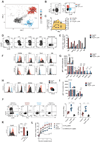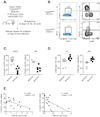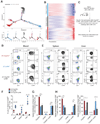CD4+ T Cell Help Is Required for the Formation of a Cytolytic CD8+ T Cell Subset that Protects against Chronic Infection and Cancer
- PMID: 31810883
- PMCID: PMC6929322
- DOI: 10.1016/j.immuni.2019.10.009
CD4+ T Cell Help Is Required for the Formation of a Cytolytic CD8+ T Cell Subset that Protects against Chronic Infection and Cancer
Abstract
Although CD4+ T cell "help" is crucial to sustain antiviral immunity, the mechanisms by which CD4+ T cells regulate CD8+ T cell differentiation during chronic infection remain elusive. Here, using single-cell RNA sequencing, we show that CD8+ T cells responding to chronic infection were more heterogeneous than previously appreciated. Importantly, our findings uncovered the formation of a CX3CR1-expressing CD8+ T cell subset that exhibited potent cytolytic function and was required for viral control. Notably, our data further demonstrate that formation of this cytotoxic subset was critically dependent on CD4+ T cell help via interleukin-21 (IL-21) and that exploitation of this developmental pathway could be used therapeutically to enhance the killer function of CD8+ T cells infiltrated into the tumor. These findings uncover additional molecular mechanisms of how "CD4+ T cell help" regulates CD8+ T cell differentiation during persistent infection and have implications toward optimizing the generation of protective CD8+ T cells in immunotherapy.
Keywords: CD4(+) T cell help; CD8(+) T cell heterogeneity; LCMV Cl13.
Copyright © 2019 Elsevier Inc. All rights reserved.
Conflict of interest statement
Declaration of Interests
The authors declare no competing interests.
Figures







Comment in
-
Back to the Future: Effector Fate during T Cell Exhaustion.Immunity. 2019 Dec 17;51(6):970-972. doi: 10.1016/j.immuni.2019.11.007. Immunity. 2019. PMID: 31851902
Comment on
-
Proliferating Transitory T Cells with an Effector-like Transcriptional Signature Emerge from PD-1+ Stem-like CD8+ T Cells during Chronic Infection.Immunity. 2019 Dec 17;51(6):1043-1058.e4. doi: 10.1016/j.immuni.2019.11.002. Epub 2019 Dec 3. Immunity. 2019. PMID: 31810882 Free PMC article.
References
-
- Barber DL, Wherry EJ, Masopust D, Zhu B, Allison JP, Sharpe AH, Freeman GJ, and Ahmed R. 2006. 'Restoring function in exhausted CD8 T cells during chronic viral infection', Nature, 439: 682–7. - PubMed
Publication types
MeSH terms
Substances
Grants and funding
LinkOut - more resources
Full Text Sources
Other Literature Sources
Molecular Biology Databases
Research Materials

